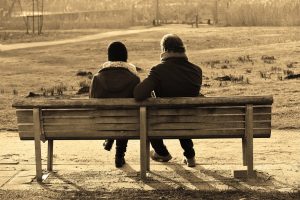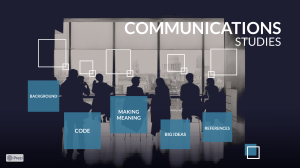8 Intro to Communications Studies
Learning Objectives
-
Discover communications studies and several of its pragmatic applications for college and career.
-
Use metacognitive reading strategies before, during and after reading fiction, non-fiction and graphics.
Chapter & Discussion
This chapter includes a presentation that can be navigated in a classroom setting or independently. You can access the presentation via the link below.
Work through the different sections of the chapter and discuss ideas and topics as they arise. If you’re working independently, take notes instead. Notes and active discussion will be helpful in navigating this week’s assignments.
Background
- Communications Studies is a social science that looks at human behavior by studying patterns of communication in:
- Personal Relationships
- Social Situations
- The Media
- World Cultures
Communication plays a role in nearly all human activities. The study of communications can help us to:
- Build stronger interpersonal relationships with others
- Become better writers and be more clear in our professional communications
- Articulate your ideas so that you can use them to
- create positive change
- Develop media literacy so that you can learn what messages to trust
Careers in Communications
There are also a number of career fields available to those who study communications, including:
Advertising
Journalism
Education
Public relations
Sales
Government
Politics
Human resources
Code
Whenever a message is created, it is encoded by the creator and decoded by the receiver. The code that’s used is usually language.
We code our messages with cues.
Verbal cues use language to make meaning (this includes writing)
Non-verbal cues use tone, gestures and other signs (like our clothing) to make meaning
The Transactional Model of communication is the idea that the sender and the receiver create meaning together.
This means that there are many factors that can affect how the receiver decodes your message. And they may not get it as you intended.

Making Meaning
We don’t communicate in a vacuum. Many other factors can affect how someone interprets our messages.
MESSAGE. This is the thing we’re trying to say. It also includes the verbal and nonverbal cues that we encode.
CONTEXT. The context of our message can include the setting, circumstances, and relationships of the receivers. It can also include a person’s worldview, culture, and lived experiences.
CODE. The code itself is usually the language we use.
CHANNEL. This is the medium used to relay the message. It could be audio, writing, sign, or even touch.
Understanding how all these factors come together can help us develop communications awareness, which can have an impact on how people respond to what we have to say.
How to Use Communications Studies
Here are some of the goals of communications studies. For each, I’ll include action items to practice in working towards that goal.
Goal #1: Strengthen Interpersonal Communication Skills. You can work towards this by practicing active listening (with your eyes, ears, and gut), taking time to understand as you try to be understood, and being aware of personal perceptual filters.
Goal #2: Develop Communication Skills for Professional Life. Here, you can work on practicing clarity in your messaging, crafting your message for your purpose and audience, and learning the standard format for a particular type of communication.
Goal #3: Use Your Ideas to Make Positive Change. This is not easily accomplished, but you can start by assessing needs, making allies with people with similar interests, and sharing your ideas with those allies.
Goal #4: Practice Media Literacy. For this goal, you can consider the sources of the media you consume and practice tools for evaluating whether or not they are trustworthy.

Assigned Reading
Here are this week’s readings. Additionally, please read for your own personal enjoyment for 1/2 hour each day. This will be called your “Reading Zone” reading and it will coincide with many upcoming activities.
How Miscommunication Happens by Katherine Hampsten via Ted Ed
Problem Set: Practice Your Skills!
Click here to complete a ten-question problem set on concepts in this chapter.
Completing problem sets like this can be an important element of independent study towards completing your HSE. I write these to resemble the style of questions you’ll find on the Reading and Language Arts GED.
Assignment: How Miscommunication Happens (250 Words)
Please complete the Ted Ed module at the following link (you will need to create a free account):
How Miscommunication Happens- Ted Ed
The module has four parts: Watch (the video), Think (a short quiz), Dig Deeper (a reading), and Discuss (a discussion post). Complete the first three parts on the Ted Ed website, and the fourth part (the discussion post) here.
Your post should be 250 words and address the prompt (which I will also repost here).
Prompt: Some may argue that good communicators are born, not made. Do you agree with this statement? How can the communication process improve our effectiveness in expressing ourselves and understanding others?
Additionally, please comment on another student’s post.
Assignment: Reading Zone Response (250 Words)
For Reading Zone, you must find a novel that is interesting to you and enjoyable to read. If you need help finding a Reading Zone book, please ask. Please read your Reading Zone book for a half-hour each day. On class days, there will be time in class dedicated to reading.
Create a response to this week’s reading that addresses the following prompts:
-
In one paragraph, summarize what you’ve read this week
-
In a second paragraph, discuss the communication style of one or two of the characters in your book.
Attributions
Hampsten, K (2016). How Miscommunication Happens. Ted Ed.
Ryder, C. (2022). Crash Course Human Communication. Crash Course and Arizona State University.


